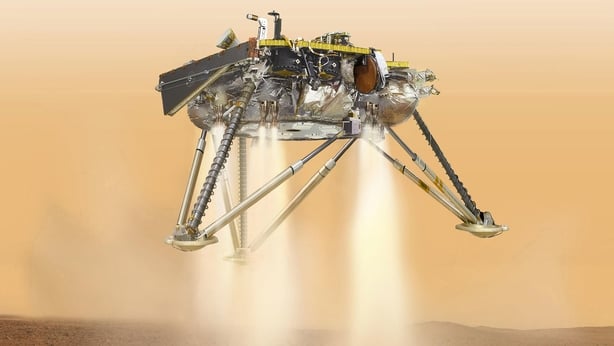NASA's first robotic lander designed to study the deep interior of Mars has landed on the surface of the Red Plant after a six-month voyage through space.
"Touchdown confirmed," a mission control operator said as cheers erupted and scientists leapt from their seats to hug each other at NASA's Jet Propulsion Laboratory.
‘Touchdown confirmed!’ – NASA celebrates after InSight lands on Mars | https://t.co/1o6whAn60F pic.twitter.com/yLxNwnoeE3
— RTÉ News (@rtenews) November 26, 2018
In a post on Twitter, NASA said that InSight sent its first picture from Mars after it landed.
My first picture on #Mars! My lens cover isn’t off yet, but I just had to show you a first look at my new home. More status updates:https://t.co/tYcLE3tkkS #MarsLanding pic.twitter.com/G15bJjMYxa
— NASAInSight (@NASAInSight) November 26, 2018
The landing capped a six-month journey of more than 548 million kilometres from Earth, following its launch from California in May.
Carrying instruments that detect planetary heat and seismic rumblings never measured anywhere else but Earth, the stationary lander streaked into the thin Martian atmosphere at 19,795km/ph.
Its 77-mile descent was then slowed by atmospheric friction, a giant parachute and retro rockets, bringing the three-legged spacecraft to a gentle landing six-and-a-half minutes later.

InSight came to rest as planned in the middle of a vast, barren plain called the Elysium Planitia, close to the planet's equator.
InSight will spend 24 months, about one Martian year, taking seismic and temperature readings to unlock mysteries about how Mars formed and, by extension, the origins of the Earth and other rocky planets of the inner solar system.
The stationary probe is programmed to pause for 16 minutes for the dust to settle, literally, around its landing site, before disc-shaped solar panels are unfurled like wings to provide power to the spacecraft.
The 360kg InSight - its name is short for Interior Exploration Using Seismic Investigations, Geodesy and Heat Transport - marks the 21st US-launched Mars mission, dating back to the Mariner fly-bys of the 1960s.
Nearly two dozen other Mars missions have been sent from other nations.
